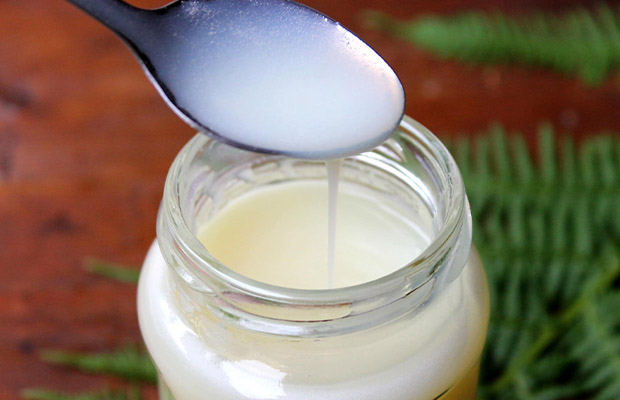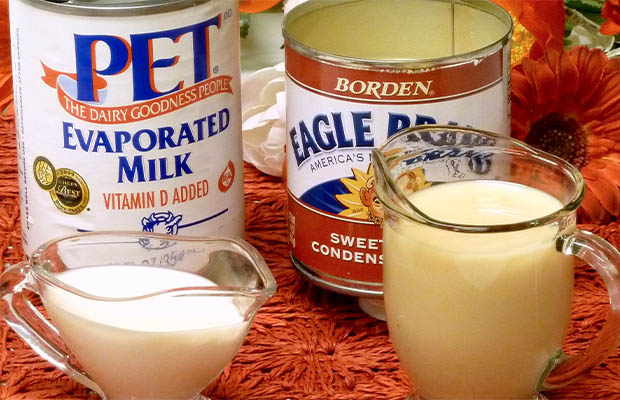Milk that has been concentrated through evaporation is also referred to as unsweetened condensed milk.
It is a canned milk product that is typically located in the baking section of your local supermarket. Even so, you might be curious about what it is and its healthfulness. Do you know the advantages and disadvantages of evaporated milk?
Each cup of evaporated milk contains more than half the recommended daily amount of calcium. However, because it also contains lactose and milk proteins, it is not recommended for those who are lactose intolerant or allergic to cow’s milk.
The nutritional advantages, drawbacks, and application of evaporated milk are all covered in this article.
Table of Contents
What Is Evaporated Milk?
About 60% of the water in regular milk is removed to create evaporated milk.
The milk is then sterilized to prevent the growth of harmful microorganisms, homogenized—a process that evenly distributes the milk’s fat—and canned.
As a result, milk becomes more concentrated, thicker, and creamier, and its flavor and color become slightly caramelized.
Its nutrient composition is still unaltered even after having more than half of its water content removed, making it a milk product with high nutrient content.
Additionally, because milk is concentrated, it can be preserved for a longer period of time, extending its shelf life.
Although there are two different types of condensed milk products—evaporated and sweetened—sweetened condensed milk is sweeter than evaporated condensed milk because it has added sugar.
Taste Of Evaporated Milk
However, if the baking recipe instructs you to add something, you must do so. It tastes a little unnatural to me.
The distinctive taste of the evaporated milk may take a few tries to get used to. However, a lot of people think it’s delectable and very helpful in many different dishes.
Milk that has been evaporated tastes the same as regular milk but is much denser and less liquid. The taste is more creamy and heavier.
Because of the process of heating required to promote evaporation, the sugars in the milk become slightly caramelized, giving it a little color and a hint of sweetness compared to traditional milk.

Uses Of Evaporated Milk
A huge variety of baking recipes can use evaporated milk, which is incredibly versatile. Here are a few of the most commonly used methods to make use of evaporated milk:
- Drinking
- Drinks that can be enriched, such as smoothies and coffee
- Making thicker, more creamy, and hot dishes
- Baking with creaminess, without excessive water content or the high-fat content of heavy cream
- Making ice cream which makes production far more cost-effective
It’s not hard to see how various things can be done with evaporated milk.
I’ll go over additional information about using evaporated milk in different ways as well as any drawbacks or restrictions it might have in the remaining section of this guide.
Vitamin And Mineral Profile Of Evaporated Milk
The following is the vitamin and mineral profile per 252-gram cup, based on USDA data for whole evaporated milk and the daily values (3, 6).
Vitamins
- Riboflavin (B2): 61.2% of the daily value (DV)
- Vitamin A, RAE: 18.2% DV
- Vitamin B12: 16.8% DV
- Choline: 14.6% DV
- Thiamin (B1): 9.8% DV
- Vitamin B6: 7.4% DV
- Vitamin C: 5.3% DV
- Folate, DFE: 5.1% DV
- Niacin (B3): 3.1% DV
- Vitamin E: 2.4% DV
- Vitamin K: 1.1% DV
There are many vitamins in evaporated milk, but riboflavin, vitamin A, vitamin B12, and choline are especially abundant.
Minerals
- Calcium: 50.6% DV
- Phosphorus: 41.0% DV
- Zinc: 17.6% DV
- Potassium: 16.3% DV
- Magnesium: 14.4% DV
- Sodium: 11.6% DV
- Selenium: 10.5% DV
- Copper: 4.4% DV
- Iron: 2.7% DV
Each cup of evaporated milk contains more than half the recommended daily amount of calcium.
Furthermore, it contains significant amounts of phosphorus, potassium, magnesium, sodium, and selenium.
Is Evaporated Milk Healthy?
Drinking evaporated milk may help people who want to eat more food or get more minerals.
Infection, dementia, and even death are all risks associated with being underweight. To avoid additional health issues brought on by bad eating practices, you might want to gain weight while doing so in a healthy way.
Due to its high concentration of nutrients and absence of added sugar, which is linked to the onset of heart disease and type 2 diabetes when consumed in excess, evaporated milk may aid in healthy weight gain.
Evaporated milk can be used to make a variety of dishes, including mashed potatoes, oatmeal, soups, and casseroles, in addition to being consumed.
Additionally, evaporated milk is naturally rich in minerals like calcium and phosphorus, which are crucial for bone health, as well as vitamin D and, occasionally, vitamin A. These fortifications are common in many nations.
Advantages Of Evaporated Milk
Vaporized milk has advantages over regular dairy milk.
Here is a summary of these potential advantages.
Higher Amount Of Nutrients Per Cup
Evaporated milk roughly doubles the protein, vitamin, and mineral content of regular milk gram-for-gram (or cup-for-cup).
Because of this, half a cup of evaporated milk has the same nutritional value as a full cup of regular milk.
In general, people don’t really drink plain evaporated milk; it’s more commonly used in recipes.
Evaporated milk, however, may be useful for people who need to get nutritional value from smaller amounts of liquid because of its concentrated nutrient provision.
Long Shelf Life
Evaporated milk can remain unopened for six months to a year, while fresh, chilled milk only keeps for a few days or a few weeks.
When the milk will taste its best is indicated by the “best by” or “best before” date printed on the can.
Evaporated milk needs to be used within 3 to 4 days after being opened and should be kept in the refrigerator.
Can Be Useful For Recipes
There are valid reasons why some recipes call for evaporated milk instead of regular milk.
For instance, a certain recipe might need milk’s fat, carbohydrate, and protein content, but not too much liquid. To put it another way, a cup of whole milk might make the recipe’s consistency too runny.
However, evaporated milk can deliver the same amount of liquid for about half the content of regular milk. As a result, the recipe can be altered to include the desired amount of milk solids without using significantly more water.
Can Be Used As A Milk Substitute
Evaporated milk isn’t a life-for-like milk substitute because of its consistency, thickness, and sweetness.
To make it resemble milk, however, it can be diluted with water (roughly one part evaporated milk to one part water).
Easier To Ship And Store Than Fresh Milk
Evaporated milk may also have the advantage of being more convenient to ship and store than fresh milk.
Shipments of evaporated milk can supply milk to the local population in places where fresh milk isn’t always readily available.
Disadvantages Of Evaporated Milk
Evaporated milk, like most food products, may have some drawbacks.
Higher Lactose Content
Evaporated milk has a much higher lactose content than fresh milk because it contains more than twice as much milk sugar.
On this note, a report published in the American Journal of Clinical Nutrition (AJCN) listed the lactose content of milk and milk products (9).
Fresh cow milk has a weight lactose content of 4-5%, according to this AJCN text. A 11% lactose content, however, is present in evaporated milk.
Evaporated milk is probably not suitable for many people with lactose intolerance because it contains more than twice as much lactose.
However, there are products marketed as “lactose-free evaporated milk” that ought to solve this problem.
Aside from the lactose problem, it’s important to note that evaporated milk has twice as many calories as milk. In other words, since it’s simple to overeat, the serving size is crucial.
Evaporated Milk Vs. Condensed Milk
There is a big difference between condensed milk and evaporated milk despite the similarities they may appear to have.
Evaporation has caused the water content of both of these milk types to decrease. However, sweetened evaporated milk has added sugar while condensed milk does not.
The fact that condensed milk contains a significant amount of added sugar should also be noted.
To illustrate this point, here is how evaporated milk and condensed milk compare for calorie and sugar content per cup serving:
- Evaporated milk (whole): 338 calories and 25.2 grams of sugar per cup (3)
- Condensed milk (whole): 976 calories and 165 grams of sugar per cup (10)
Condensed milk is commonly employed in the creation of sweet sauces and desserts due to its understandable sweetness.
How To Make Evaporated Milk At Home?
We can quickly make evaporated milk at home because the process to do so is fairly simple.
Here is a simple procedure to follow to make it at home:
- In your preferred cooking pot or pan, add 500 ml of milk to make 250 ml of evaporated milk. Alternatively, use twice as much milk as evaporated milk.
- While stirring occasionally, heat the milk until it begins to simmer.
- To prevent the milk from boiling, keep it simmering and adjust the heat as necessary.
- The evaporated milk ought to be ready in 25 to 30 minutes. The milk should gradually become less (to half the original amount at the end) and gradually change color to a more golden-cream hue.
Read More: Can You Make Homemade Powdered Butter?
Final Thoughts
Fresh milk’s nutrients can be concentrated in evaporated milk.
It has the same nutritional advantages and disadvantages as fresh milk, but they are more “concentrated.”‘
Despite having more healthy nutrients than milk, evaporated milk also has higher levels of calories, fat, and lactose.
For those who can consume milk products, evaporated milk can be used in moderation as part of a healthy diet.
Read More: How To Make Powered Milk?
FAQs
Can I substitute evaporated milk for condensed milk?
In a 1:1 ratio, evaporated milk can be substituted for condensed milk. It hinges, though, on the qualities that the final recipe should have. For instance, the sweetness and texture of evaporated milk won’t be quite as thick or sweet as those of condensed milk.
Is evaporated milk a sugary beverage?
Regular fresh milk has about half as much sugar as evaporated milk, which has 10–11% sugar by weight. But compared to sweetened condensed milk, it has much less sugar.
Does evaporated milk make you gain weight?
No food or drink inherently causes weight gain (or weight loss). What matters is your diet as a whole. However, if consumed in excess on a regular basis, evaporated milk can undoubtedly cause weight gain as it is a simple way to consume a lot of extra calories.
Is it safe to consume evaporated milk when pregnant?
Yes, drinking evaporated milk while pregnant is absolutely safe.
A friend of mine once confided that following her pregnancy, she only consumes powdered milk. She doesn’t consume fresh milk because liquid milk is pasteurized and given additional ingredients to extend the milk’s shelf life. In contrast, powdered milk is processed to maintain freshness without the need for additional ingredients.
Condensed milk contains more sugar than regular milk, so you should exercise caution.
Is evaporated milk vegan?
The milk used to make traditional evaporated milk is from cows. There are milk varieties made from plants that have been evaporated, but they are not vegan.
One can buy evaporated coconut milk from Nature’s Charm. It serves as a vegan, dairy-free alternative to evaporated milk that can be consumed or used in recipes. Although it can be a great texture or consistency comparison, it is much sweeter than conventional evaporated milk.

